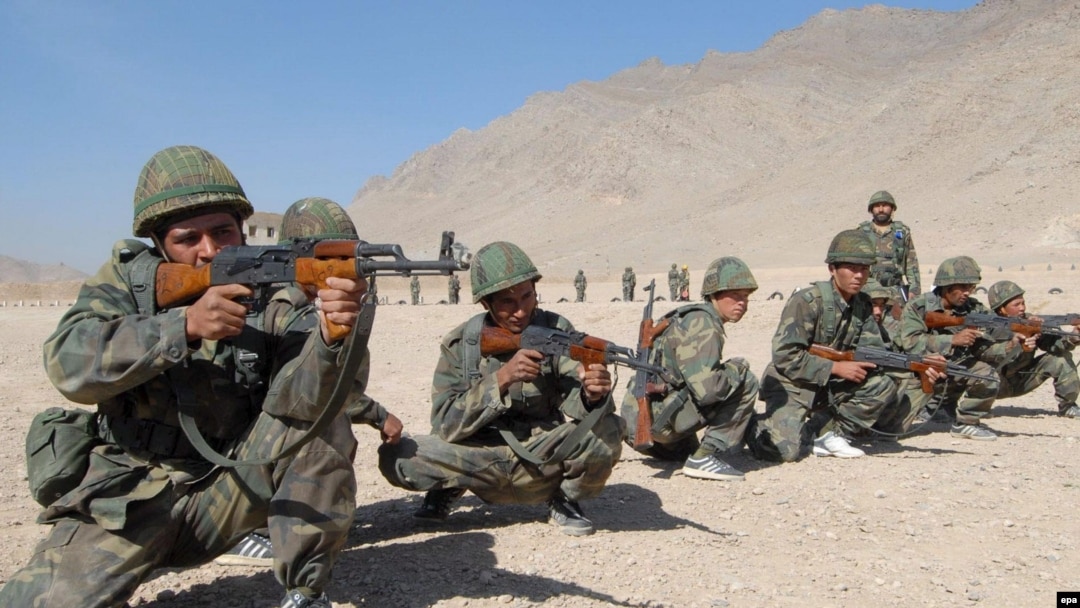KANDAHAR, September 20, 2007 (RFE/RL) -- It is symptomatic of some of the woes of Afghanistan that the higher the rank of the person you talk to, the more optimistic they are.
Drawing on seemingly inexhaustible reserves of pride, the Afghan National Army's top officers are anxious to drum up respect for the institution they represent -- and talk down the prowess of their enemy.
The soldiers on the ground, however, appear a good deal more guarded in their assessments, and their accounts are more in keeping with the slow progress of the ANA and its Western backers in Afghanistan's deep south.
Brigadier General Gul Aqa Nahib commands about 10,000 soldiers who make up the ANA's southern 205th Corps, which has headquarters at the Kandahar Airfield, side by side with the International Security Assistance Force's (ISAF) Regional Command South.
In an interview on September 9, Nahib initially brimmed with optimism, saying the Taliban are no longer capable of defeating ANA units in combat.
"The enemy knows our abilities," Nahib said. "Before, they came to fight face-to-face with the ANA, but now they have lost that ability; they cannot come face-to-face in combat. They just have ambushes, terrorist attacks like suicide attacks, bombings, road bombings. They cannot stand up to us as fighters."
General Nahib says the ANA has beaten Taliban insurgents many times, taking their weapons and equipment. He says the four southern provinces of Kandahar, Helmand, Zabul, and Uruzgan -- each home to an ANA brigade -- are now secure. He said he is now "very happy with the security situation."
But this account does not match the news of continued fighting southwest of Kandahar -- and constant Taliban attacks in Helmand, Zabul, and Uruzgan -- which dominated the headlines in Afghanistan in mid-September.
When challenged, General Nahib concedes that "some areas" remain where the Taliban is still active, but says they will be "freed soon." He declines to predict when.
Still Dependent On ISAF
The core of the ANA's problem, Western officials say, is that it cannot hold on to the territory won for it by ISAF. It lacks the manpower, equipment, and experience necessary.
Asked if the ANA still needs ISAF, General Nahib conceded. "I can tell you that the ANA cannot stand on its own feet yet, but it will do so in the future," he said. "We are not fully equipped yet and we do not have enough men. When we have enough men and we are fully equipped then we can beat all of them." He noted that the ANA recently conducted two operations without the support of coalition forces.
The governments of ISAF allies are currently supplying the ANA with weapons and equipment, but that process has -- by all accounts -- not reached an advanced stage. Some NATO officials complain that the Afghan Defense Ministry has yet to make the basic policy decision of whether to adopt NATO standards or not.
The ANA soldiers interviewed all said that their worst deficiency was the lack of heavy weapons and air power. This, they said, is the main factor which makes the ANA dependent on ISAF.
In Zabul Province, at Forward Operations Base Massud -- which is operated by Romanian troops -- ANA Sergeant Rahimullah Abdullah said that "if it weren't for ISAF, no one would prevent the Taliban" from overrunning the province. He said the ANA needs "rockets, PKMs [machine guns], hand guns, vehicles, RPGs, all kinds of weapons."
In neighboring Uruzgan, at the Dutch outpost of Chora, hemmed in by mountains on all sides, the relatively well-equipped elite ANA soldiers said their biggest ambition is to acquire the ability to project their own air power.
Untrained Soldiers
Training is another problem. There are currently 26 ISAF "Operational Mentoring and Liaison Teams" (OMLTs, or "omelettes" as they are known in ISAF jargon) training ANA units across the country.
However, the number barely meets the needs of the 30,000-35,000 current ANA soldiers. The ANA is projected to grow to 70,000 men by the end of 2008, requiring 100 of the 20- to 30-person OMLTs, not an easy task for Western governments struggling to find troops for Afghanistan.
But there are some problems that are even more elementary. ISAF Brigadier General Ryszard Wisniewski, in charge of coordinating some Western training efforts, said in a video interview from Kabul on September 17 that a flagship project to attach 65 ANA officers to ISAF central and regional headquarters is in danger of foundering because many of these hand-picked officers cannot read or write.
"The biggest problem that we met is language skills," Wisniewski said. "Sometimes we have some examples of people who are not able to even read or write in Dari or Pashto." That leaves ISAF with the challenge of running training efforts when it cannot even recruit suitable candidates, he said.
If there is one commodity with which the ANA appears to be well-supplied, it is spirit. The ANA soldiers' morale appears to be high, and Dutch, Australian, and Canadian officers had only praise for the troops.
Some western officials sound a note of caution, however.
One leading ISAF figure pointed out that the ANA troops in the south overwhelmingly consist of non-locals -- mostly Tajiks and Uzbeks, with a greater motivation to fight an almost exclusively Pashtun insurgency.
Brigadier General Nahib, a Dari speaker from the country's north, confirms that although the ANA is "a symbol of national unity," its policy is to send Pashtuns away from the country's south to serve elsewhere.
RFE/RL Afghanistan Report
SUBSCRIBE For regular news and analysis on Afghanistan by e-mail, subscribe to "RFE/RL Afghanistan Report."


